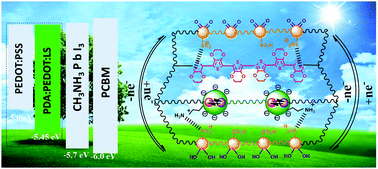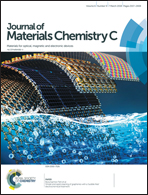Simultaneouly enhanced durability and performance by employing dopamine copolymerized PEDOT with high work function and water-proofness for inverted perovskite solar cells†
Abstract
Poly(3,4-ethylenedioxythiophene):polystyrene sulfonate (PEDOT:PSS) is widely applied in inverted perovskite solar cells (PSCs). Its relatively low work function (WF) and high hydrophilicity hinder the achievement of high power conversion efficiency and device stability. This article describes a novel and readily available approach to enhancing the WF and waterproofness of PEDOT by copolymerising dopamine (DA) with a PEDOT backbone via an efficient radical coupling reaction between 3,4-ethylenedioxythiophene (EDOT), DA and sustainable lignosulfonate as the dopant under mild oxidation. The product, PDA:PEDOT:LS, had a WF of 5.45 eV due to electron transfer in the phenol–quinone–PEDOT backbone. The open-circuit voltage of PDA:PEDOT:LS was 1.02 V, compared with 0.86 V for PEDOT:PSS, and it had a higher power conversion efficiency. PDA:PEDOT:LS exhibited much lower acidity, with a pH of 5.3, excellent waterproofness and lowered hydrophilicity due to the cross-linking copolymerisation between 3,4-ethylenedioxythiophene (EDOT), DA and lignosulfonate. The greater waterproofness will have a key practical application in improving the durability of PSC devices.



 Please wait while we load your content...
Please wait while we load your content...